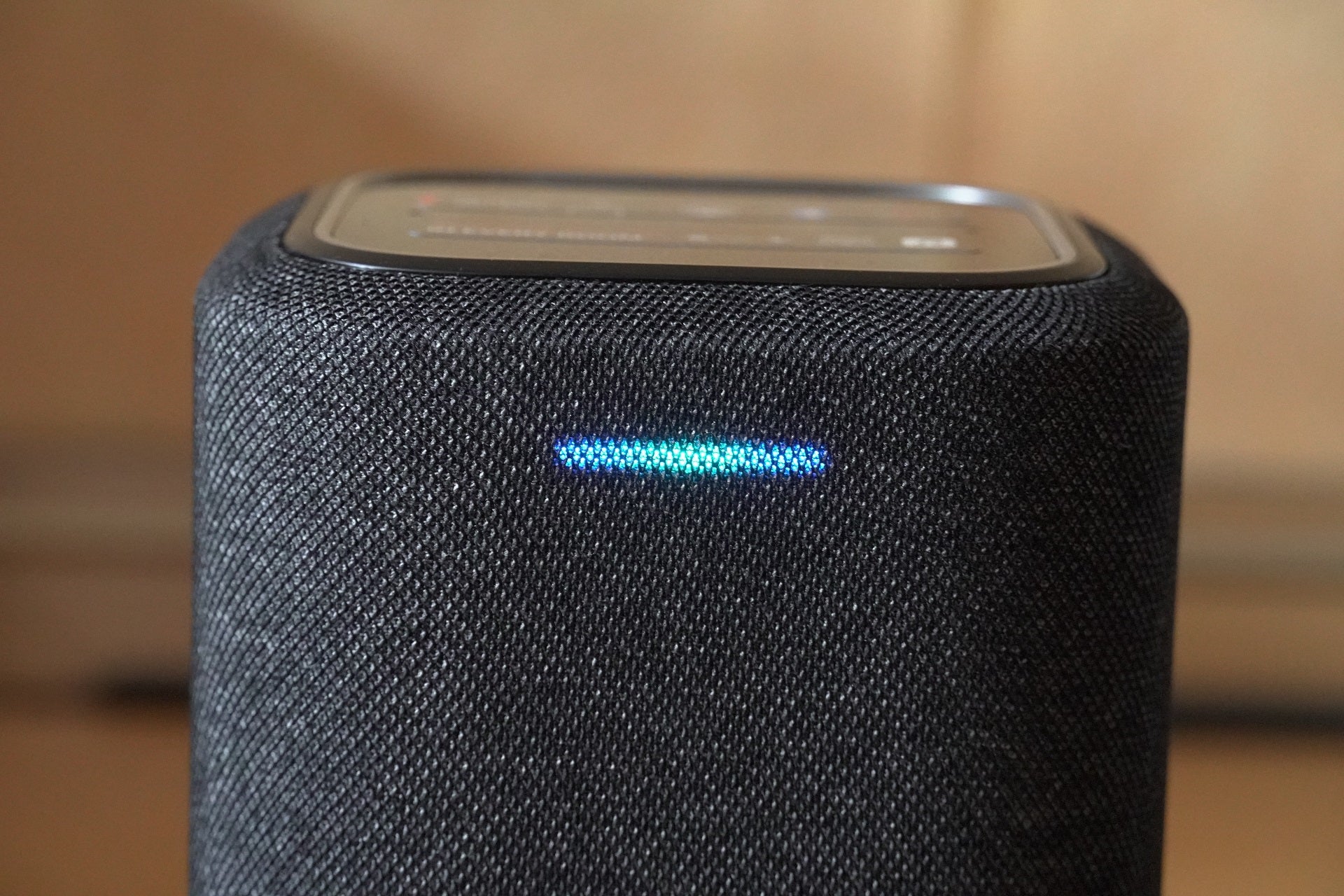Verdict
For those who want their smart speakers to be truly smart, the Home 150 now packs the promised support for Alexa. Sonos still edges the Denon overall, but the Home 150 is a wireless speaker that pushes out out a fun performance good.
Pros
- Enjoyably bombastic
- Big sound
- Smart looks
- Now with native voice support
Cons
- Sonos One sounds better balanced
- More expensive than Sonos
Availability
- UKRRP: £219
- USARRP: $249
- EuropeRRP: €249
- CanadaRRP: CA$399
- AustraliaTBC
Introduction
The Home 150 is the smallest effort in the Denon’s wireless speaker range, with smarts, built-in HEOS and Hi-Res audio skills.
Denon’s Home series of speakers is its answer to Sonos’ domination of the multi-room speaker market. Denon certainly has the pedigree, and both the Home 350 and Home 250 delivered. Can it make it a three-peat?
Design
- Black or white finishes
- Status light hidden at the bottom
- Connections around the rear
The Home 150 shares the same look as its bigger siblings. It’s not as minimalist as the Sonos One, but approaches that level of anonymity. Tucked inside is a mono speaker with two Class D amplifiers driving a 25mm tweeter and 89mm woofer.
Available in black or white, the speaker comes wrapped in fabric and on tip is a touch panel made of hardened glass and features presets (up to three), volume and playback controls. Hover over it and proximity sensors illuminate the controls.
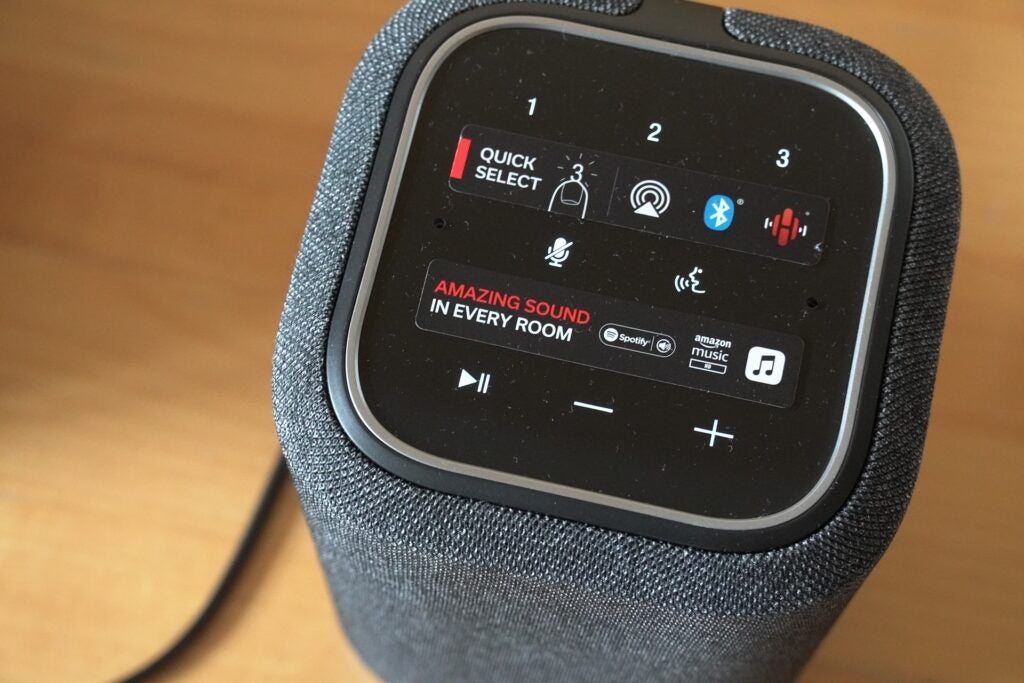
Down at the bottom is a small status light. When in operation it’s blue but changes colour based on the action such as updating (orange) or Bluetooth pairing (green). The intensity of the light can be changed in the HEOS app.
Around the back is a screw thread for wall-mounting, a Connect button for joining the HEOS network: Ethernet socket, USB port, Aux-in and a button for enabling Bluetooth. Though it’s mains-powered, the supplied cable is of decent length so you shouldn’t have to worry about being too far from a mains outlet.
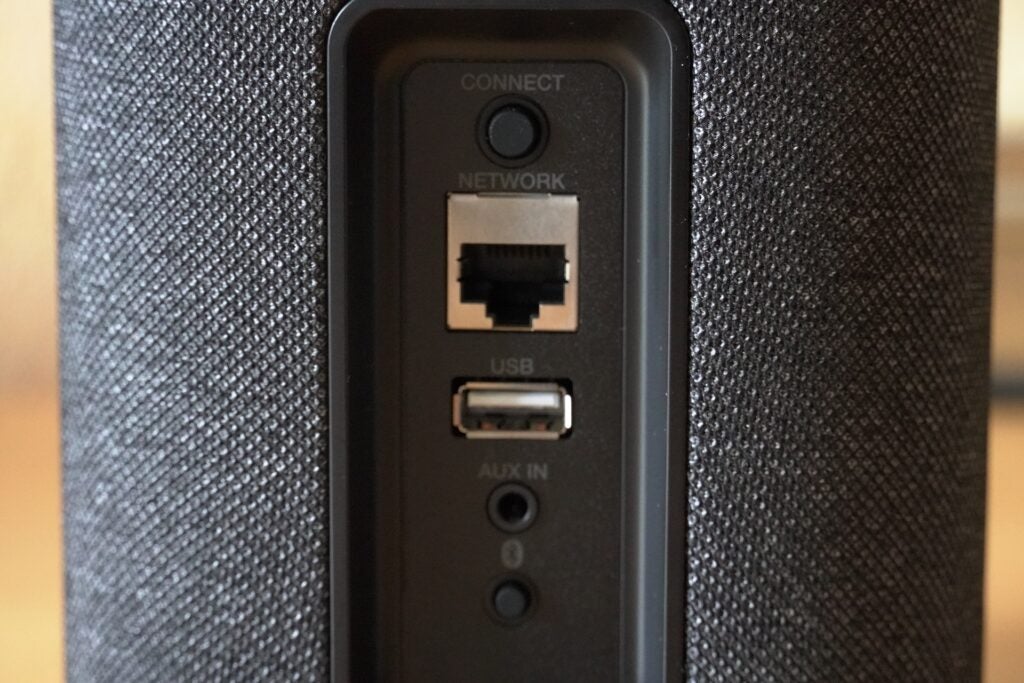
The Home 150 weighs 1.7kg – fractionally less than the Sonos One despite being taller (187 x 120 x 120 HWD, mm). It’s a fair-looking effort in the sense that it’s not intended to grab your attention. It’s the audio that does the Home 150’s talking.
Features
- Now features native voice assistant
- HEOS app brings music streaming service access
- Hi-res audio possible via USB
Its taken over two-and-a-half years but Denon finally has native voice assistance. If you’re in the Amazon Alexa ecosystem, you can ask Home 150 a question and it finally has a voice to respond back with.
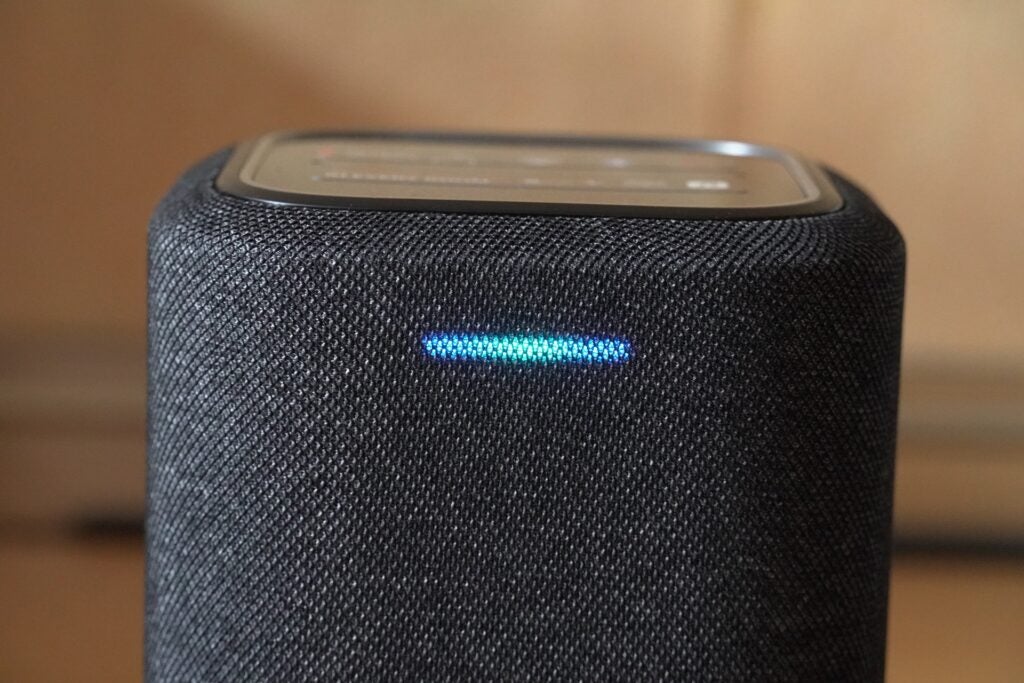
The HEOS app (Android, iOS) is the gateway to Denon’s interconnected ecosystem, and allows the user to rule as overlord across any HEOS devices in the home.
It offers integration with music streaming services such as Spotify, TuneIn, Amazon Music, Deezer, SoundCloud, Napster and Tidal. There’s access to EQ settings, customisation; bass optimisation, which works in real time in a recent update, optimisation of bass which works in real time, too.
The HEOS app is a tidy, if basic interface that lacks the modern sheen of the Sonos control app. Streaming service support includes; and Spotify aside, libraries, search and playback of content can be managed within HEOS. A HEOS account needs to be set up to take advantage of all this.

The Home 150 supports Wi-Fi (2.4 and 5GHz), Bluetooth 4.2 and AirPlay 2 (which brings Siri into the equation). There’s a slight lag when using AirPlay, which is not always helpful when jumping back and forward through a playlist.
File support includes MP3, AAC and WMA, and stretches to Hi-Res with 192kHz/24-bit FLAC, WAV, ALAC and DSD 2.8/5.6MHz. These files can be played over the network or via the rear USB port.
The Denon Home 150 can be used as a stereo pair, or as rear surrounds for the Denon Home Sound bar 550 to create a 5.1 system.
Sound Quality
- Goes loud
- Bold presentation
- Decent dynamics
Despite its size, the Home 150 is a speaker that needs no invitation to go loud. It’s not the widest soundstage due to its dimensions, but it packs plenty of bass which has been refined a little since the bass tuning update. Compared to the One SL, it’s bolder in its presentation, but lacks the subtlety of the Sonos.
Vocals are articulated well, pushing them forward from the rest of the mix. Jill Scott’s voice Golden is convincingly reproduced, the Home 150 capturing her breathy tones and inflections.
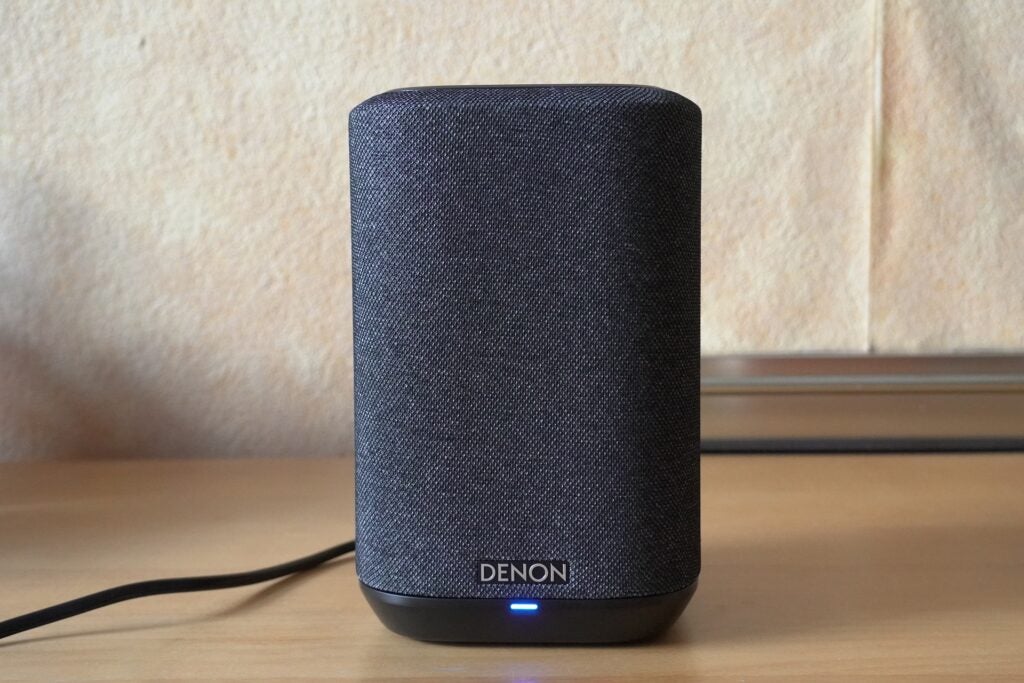
Volume can be a slightly tricky to gauge and needs adjustment regularly. What was right for one song wasn’t necessarily fitting for another, especially at high volumes. Another thing to take heed of is streaming Tidal through the HEOS app. It only streams Masters’ tracks at 16-bit, not 24-bit, which is a disappointment.
Dynamically there’s a good sense of rise and fall, the sweeping nature of Ennio Morricone’s The Untouchables is given an enjoyable rendition as the Home 150 retreats during quieter moments before springing into life, underlining the track’s heroic nature.
Tonally it’s a rather warm and thick in its presentation. There’s a good, full-bodied presence to it, the organ from Hans Zimmer’s Where We’re Going? has a nice sense of weight and heft. Treble is rolled off a little, not quite as sharp or as piercing, but enjoyably described.
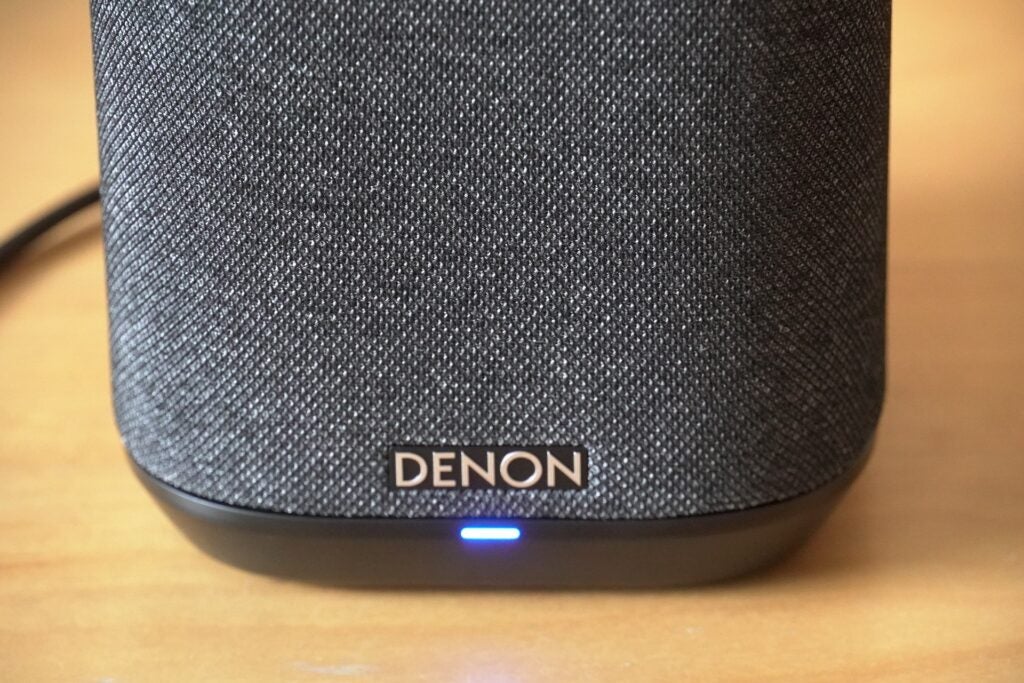
There’s more bass on tap than in the Sonos One, and bass is more controlled than it is with the Marshall Uxbridge, with the update taming the Home 150’s bassy tendencies for better balance and control. Even so, the Home 150 offers a good amount of low frequency energy. One issue is the slightly tubby, ill-defined notes between the mid-range and bass. It’s not a huge worry, but some notes aren’t quite as clear as I’d like.
Latest deals
Should you buy it?
You want a fun listening experience If you enjoy bass then this speaker rumbles better than most, especially for its size.
You want a more affordable smart speaker There’s not much in it, but the Sonos One is cheaper by about £20
Final Thoughts
Sonos remains the elephant in the room, and the 150 lacks the subtlety, midrange detail and even-handed balance of its rival; The Home 150’s warm character makes its tone a bit thicker, losing out in terms of zip and attack. Put that aside though, and the Denon Home 150 puts in an energetic, smooth and loud performance.
How we test
We test every wireless speaker we review thoroughly over an extended period of time. We use industry standard tests to compare features properly. We’ll always tell you what we find. We never, ever, accept money to review a product.
Find out more about how we test in our ethics policy.
FAQs
No, at least not in the sense that it can be taken outside. It’s powered by a mains cable and doesn’t have a built-in battery, so can only be moved about in the home.
Jargon buster
Alexa
Amazon’s smart voice assistant
Verdict
For those who want their smart speakers to be truly smart, the Home 150 now packs the promised support for Alexa. Sonos still edges the Denon overall, but the Home 150 is a wireless speaker that pushes out out a fun performance good.
Pros
- Enjoyably bombastic
- Big sound
- Smart looks
- Now with native voice support
Cons
- Sonos One sounds better balanced
- More expensive than Sonos
Availability
- UKRRP: £219
- USARRP: $249
- EuropeRRP: €249
- CanadaRRP: CA$399
- AustraliaTBC
Introduction
The Home 150 is the smallest effort in the Denon’s wireless speaker range, with smarts, built-in HEOS and Hi-Res audio skills.
Denon’s Home series of speakers is its answer to Sonos’ domination of the multi-room speaker market. Denon certainly has the pedigree, and both the Home 350 and Home 250 delivered. Can it make it a three-peat?
Design
- Black or white finishes
- Status light hidden at the bottom
- Connections around the rear
The Home 150 shares the same look as its bigger siblings. It’s not as minimalist as the Sonos One, but approaches that level of anonymity. Tucked inside is a mono speaker with two Class D amplifiers driving a 25mm tweeter and 89mm woofer.
Available in black or white, the speaker comes wrapped in fabric and on tip is a touch panel made of hardened glass and features presets (up to three), volume and playback controls. Hover over it and proximity sensors illuminate the controls.

Down at the bottom is a small status light. When in operation it’s blue but changes colour based on the action such as updating (orange) or Bluetooth pairing (green). The intensity of the light can be changed in the HEOS app.
Around the back is a screw thread for wall-mounting, a Connect button for joining the HEOS network: Ethernet socket, USB port, Aux-in and a button for enabling Bluetooth. Though it’s mains-powered, the supplied cable is of decent length so you shouldn’t have to worry about being too far from a mains outlet.

The Home 150 weighs 1.7kg – fractionally less than the Sonos One despite being taller (187 x 120 x 120 HWD, mm). It’s a fair-looking effort in the sense that it’s not intended to grab your attention. It’s the audio that does the Home 150’s talking.
Features
- Now features native voice assistant
- HEOS app brings music streaming service access
- Hi-res audio possible via USB
Its taken over two-and-a-half years but Denon finally has native voice assistance. If you’re in the Amazon Alexa ecosystem, you can ask Home 150 a question and it finally has a voice to respond back with.

The HEOS app (Android, iOS) is the gateway to Denon’s interconnected ecosystem, and allows the user to rule as overlord across any HEOS devices in the home.
It offers integration with music streaming services such as Spotify, TuneIn, Amazon Music, Deezer, SoundCloud, Napster and Tidal. There’s access to EQ settings, customisation; bass optimisation, which works in real time in a recent update, optimisation of bass which works in real time, too.
The HEOS app is a tidy, if basic interface that lacks the modern sheen of the Sonos control app. Streaming service support includes; and Spotify aside, libraries, search and playback of content can be managed within HEOS. A HEOS account needs to be set up to take advantage of all this.

The Home 150 supports Wi-Fi (2.4 and 5GHz), Bluetooth 4.2 and AirPlay 2 (which brings Siri into the equation). There’s a slight lag when using AirPlay, which is not always helpful when jumping back and forward through a playlist.
File support includes MP3, AAC and WMA, and stretches to Hi-Res with 192kHz/24-bit FLAC, WAV, ALAC and DSD 2.8/5.6MHz. These files can be played over the network or via the rear USB port.
The Denon Home 150 can be used as a stereo pair, or as rear surrounds for the Denon Home Sound bar 550 to create a 5.1 system.
Sound Quality
- Goes loud
- Bold presentation
- Decent dynamics
Despite its size, the Home 150 is a speaker that needs no invitation to go loud. It’s not the widest soundstage due to its dimensions, but it packs plenty of bass which has been refined a little since the bass tuning update. Compared to the One SL, it’s bolder in its presentation, but lacks the subtlety of the Sonos.
Vocals are articulated well, pushing them forward from the rest of the mix. Jill Scott’s voice Golden is convincingly reproduced, the Home 150 capturing her breathy tones and inflections.

Volume can be a slightly tricky to gauge and needs adjustment regularly. What was right for one song wasn’t necessarily fitting for another, especially at high volumes. Another thing to take heed of is streaming Tidal through the HEOS app. It only streams Masters’ tracks at 16-bit, not 24-bit, which is a disappointment.
Dynamically there’s a good sense of rise and fall, the sweeping nature of Ennio Morricone’s The Untouchables is given an enjoyable rendition as the Home 150 retreats during quieter moments before springing into life, underlining the track’s heroic nature.
Tonally it’s a rather warm and thick in its presentation. There’s a good, full-bodied presence to it, the organ from Hans Zimmer’s Where We’re Going? has a nice sense of weight and heft. Treble is rolled off a little, not quite as sharp or as piercing, but enjoyably described.

There’s more bass on tap than in the Sonos One, and bass is more controlled than it is with the Marshall Uxbridge, with the update taming the Home 150’s bassy tendencies for better balance and control. Even so, the Home 150 offers a good amount of low frequency energy. One issue is the slightly tubby, ill-defined notes between the mid-range and bass. It’s not a huge worry, but some notes aren’t quite as clear as I’d like.
Latest deals
Should you buy it?
You want a fun listening experience If you enjoy bass then this speaker rumbles better than most, especially for its size.
You want a more affordable smart speaker There’s not much in it, but the Sonos One is cheaper by about £20
Final Thoughts
Sonos remains the elephant in the room, and the 150 lacks the subtlety, midrange detail and even-handed balance of its rival; The Home 150’s warm character makes its tone a bit thicker, losing out in terms of zip and attack. Put that aside though, and the Denon Home 150 puts in an energetic, smooth and loud performance.
How we test
We test every wireless speaker we review thoroughly over an extended period of time. We use industry standard tests to compare features properly. We’ll always tell you what we find. We never, ever, accept money to review a product.
Find out more about how we test in our ethics policy.
FAQs
No, at least not in the sense that it can be taken outside. It’s powered by a mains cable and doesn’t have a built-in battery, so can only be moved about in the home.
Jargon buster
Alexa
Amazon’s smart voice assistant



















